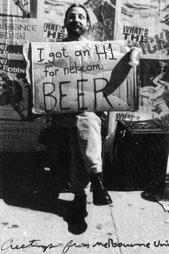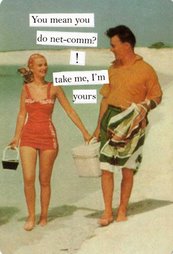
"Browser art may be defined as the net.art which recognizes the authority of the web browser as the great contemporary art frame but refuses to cede the final word on the look and function of this frame to the technical, corporate mass media" (Lui, 2006: 348)
3.1 Code and protocol politics
"code is the geology, at once a historical trace of our activities, and a determining circumstance, the ground we stand on dictating the life of the environment." (Corby, 2006:76)
Corby uses the above aerial photographs of non-virtual landscapes to illustrate the cyber analogy he draws between virtual and non-virtual colonization. Code's attempts to tame the informational flux of the net in similar ways to the methods employed by European empire builders - by imposing borders and plotting well-worn courses through which we can traverse (2006:75). Net.art is contingent on and coterminous with this code. The structural language of the net limits the content of it's critique, as artists can only engage with a subject to the extent that they are authorized to. Certain proprietary interests are protected and mainstream browsers arbitrarily impose models of language limiting access to the communication flux of the network, "software is regulatory, it is political...mainstream software hides the markers of ideological bias both within its coding and its graphic user interface (Corby, 2006: 112)
3.2 hardware and compatibility
Although net.art is no longer besieged by the hectic pace of mid 90s browser and software upgrades, which at the peak of the dot.com boom saw software turnaround times as low as four months; preservation of net.art from this era relies on the maintenance of out-date hard and software inventories by not-for-profit organizations and galleries (Wands, 2006: 185). The fate of these works is what leads Lui to ask, "what is the function of creative arts in a world of perpetual innovation which submits history to creative destruction? (Lui, 2006: 322)
Besides the system parameters net.artists must create then embed their pieces within, we mustn't take the reception of their critique for granted. There are vitiating factors within networks which limit, spoil or in some cases deny net.art's reception. Among them, low bandwidth browser access to the web, and incompatible programing languages (Wands, 2006: 186). This is a particularly crippling limitation because with some pieces of net.art there is no way of recapturing then reliving the 'first-time', 'one-off' experience of blindness and confusion intended by the net.artist, if the initial spontaneity is lost and the message allowed to dissipate (White, 2006: 112)
3.3 hypertextuality
One one hand, hypertext amplifies net.art's critique capabilities by allowing it to, "...extend the narrative of individual works over multiple pages, spatializing the text by its irregularity and dispersal across web pages, often transferring text into something filmic" (Greene, 2004: 104) But conversely, this multifariousness of entry and exit points jeopardizes the message intended to be conveyed by the net.artist. Lévy calls this 'the immanence of the message to the receiver', spectators are immersed in hypertext, "they can transform it and be author of it in part...the interconnection dispossesses a potential author of her prerogative as guarantor of meaning" (Lévy, 2001: Ch9). Net.art is limited by users right to techno-determinism.
3.4 Reconnoitre Dysfunctional web browser (1997-1999) Tom Corby

Echoing the point i made earlier about Jodi's alternative web browser; though it is available to download for free online, Reconntoire's cross-pollination of programming and aesthetic domains, is illustrative of the limits of quoting performative failure or providing abstract radical alternatives to functional mainstream equivalents, as a political tactic to render socio-political critique (White, 2006: 111). Corby comes to its defence, however, insisting that the sidelining of functionality altars the user's relationship with the net, changing it from one of consumption to reflection (Corby, 2006: 112).
But reflection is not activism, in fact it needn't even be a precursor to it. Net.art leaves the job half-done, enlightening spectators then retreating, rather than empowering users with operational alternatives that could potentially see movement away from the subjects of critique. Corby is unphased by his project's 'precarious relationship with functionality' (White: 2006, 111), "...it is less concerned with the coherent display of information as with representing browsing as a behavioral activity, and our experience of the network as a bizarre_scape; an environment with a high metabolism whose boundaries are continuously re-shaped; accreting and thickening under the influence of powerful social and commercial forces." (reconnoitre)
3.2 hardware and compatibility
Although net.art is no longer besieged by the hectic pace of mid 90s browser and software upgrades, which at the peak of the dot.com boom saw software turnaround times as low as four months; preservation of net.art from this era relies on the maintenance of out-date hard and software inventories by not-for-profit organizations and galleries (Wands, 2006: 185). The fate of these works is what leads Lui to ask, "what is the function of creative arts in a world of perpetual innovation which submits history to creative destruction? (Lui, 2006: 322)
Besides the system parameters net.artists must create then embed their pieces within, we mustn't take the reception of their critique for granted. There are vitiating factors within networks which limit, spoil or in some cases deny net.art's reception. Among them, low bandwidth browser access to the web, and incompatible programing languages (Wands, 2006: 186). This is a particularly crippling limitation because with some pieces of net.art there is no way of recapturing then reliving the 'first-time', 'one-off' experience of blindness and confusion intended by the net.artist, if the initial spontaneity is lost and the message allowed to dissipate (White, 2006: 112)
3.3 hypertextuality
One one hand, hypertext amplifies net.art's critique capabilities by allowing it to, "...extend the narrative of individual works over multiple pages, spatializing the text by its irregularity and dispersal across web pages, often transferring text into something filmic" (Greene, 2004: 104) But conversely, this multifariousness of entry and exit points jeopardizes the message intended to be conveyed by the net.artist. Lévy calls this 'the immanence of the message to the receiver', spectators are immersed in hypertext, "they can transform it and be author of it in part...the interconnection dispossesses a potential author of her prerogative as guarantor of meaning" (Lévy, 2001: Ch9). Net.art is limited by users right to techno-determinism.
3.4 Reconnoitre Dysfunctional web browser (1997-1999) Tom Corby

Echoing the point i made earlier about Jodi's alternative web browser; though it is available to download for free online, Reconntoire's cross-pollination of programming and aesthetic domains, is illustrative of the limits of quoting performative failure or providing abstract radical alternatives to functional mainstream equivalents, as a political tactic to render socio-political critique (White, 2006: 111). Corby comes to its defence, however, insisting that the sidelining of functionality altars the user's relationship with the net, changing it from one of consumption to reflection (Corby, 2006: 112).
But reflection is not activism, in fact it needn't even be a precursor to it. Net.art leaves the job half-done, enlightening spectators then retreating, rather than empowering users with operational alternatives that could potentially see movement away from the subjects of critique. Corby is unphased by his project's 'precarious relationship with functionality' (White: 2006, 111), "...it is less concerned with the coherent display of information as with representing browsing as a behavioral activity, and our experience of the network as a bizarre_scape; an environment with a high metabolism whose boundaries are continuously re-shaped; accreting and thickening under the influence of powerful social and commercial forces." (reconnoitre)




